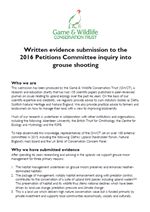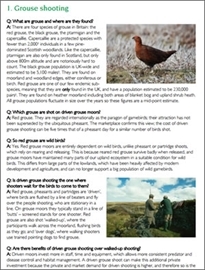Who we are
| Download PDF |
|
You can download
our evidence
submission as a
fully referenced PDF

Download PDF »
|
This submission has been produced by the Game & Wildlife Conservation Trust (GWCT), a research and education charity that has had 135 scientific papers published in peer-reviewed journals on issues relating to upland ecology over the past 46 years. On the basis of our scientific expertise and credibility, we regularly provide advice to such statutory bodies as Defra, Scottish Natural Heritage and Natural England. We also provide practical advice to farmers and landowners on how to manage their land with a view to improving biodiversity.
Much of our research is undertaken in collaboration with other institutions and organisations, including the following: Aberdeen University, the British Trust for Ornithology, the Centre for Ecology and Hydrology and the RSPB.
To help disseminate this knowledge, representatives of the GWCT sat on over 100 external committees in 2015, including the following: Defra’s Upland Stakeholder Forum, Natural England’s main board and the UK Birds of Conservation Concern Panel.
Why we have submitted evidence
After spending 46 years researching and advising in the uplands we support grouse moor management for three primary reasons:
- The habitat management undertaken on grouse moors preserves and enhances heather dominated habitats.
- The package of management, notably habitat enhancement along with predator control contributes to the conservation of a suite of upland bird species including upland waders. This preservation of habitat and its wildlife thus stems national declines which have been driven by land-use change, predation pressure and climate change.
- This is a land use which delivers high nature conservation value but is funded primarily by private investment and supports local communities economically, socially and culturally.
Executive summary
1. Protecting habitat and species
- As a consequence of red grouse relying on heather as their primary food source, grouse shooting is the only management system that explicitly maintains and enhances one of the rarest habitats in the world: heather-dominated moorland.
- Do critics of grouse moor management agree that driven grouse moors have been successful in protecting these conservation priority habitats and species for the nation?
- Read more
2. Sustainability
- Our moorlands are home to specialist flora and fauna and deliver a range of other public goods and services such as drinking water, carbon storage and recreation.
- Do the critics of grouse moor management accept that there is always a sustainability balance between environmental, social and economic considerations?
- Read more
3. Funding for upland conservation
- This complex and wonderful moorland habitat is enjoyed by millions of visitors each year, but it is on grouse moors, invariably as a result of the private investment, that they will see high numbers of curlew and other threatened species.
- A ban on driven grouse shooting would result in a drop in the private investment in conservation by moor owners. Those proposing the ban should be challenged to explain how much additional government or charitable funding would be required.
- Read more
4. Alternative land uses
- It is unlikely that these unique habitats and upland bird populations can be maintained at current levels, along with local economic and social factors without driven grouse shooting.
- Those proposing changes to ban or restrict driven grouse shooting should be challenged to produce evidence of the net gain that the alternative land uses they propose will bring to society – economic, social and environmental.
- Read more
5. Selective use of evidence
- The evidence for many of the criticisms made of red grouse shooting is far from clear, accurate or balanced. Further research, over the medium to long term, is required.
- Supporters of a ban on driven grouse shooting should be challenged to explain the clear imbalance in their evidence. Secondly there is a failure to recognise the associated risks that may result from changes in practice.
- Read more
6. Additional regulation
- The Defra hen harrier management plan and brood management scheme does address the conflict and should be given a chance to work where legislation has failed.
- What measurable outcomes are those proposing greater regulation trying to achieve, and why do they feel the extensive existing regulation can’t achieve them?
- Read more
7. Finding working solutions
- Trialling Defra’s proposed remedy to the hen harrier conflict is critical. Without the incentive of grouse shooting there is little motivation to maintain our heather moorlands, as evidenced on Welsh moorland when driven grouse shooting ended.
- Are those calling for the banning or licensing of grouse moors to protect birds of prey more focused on processes than a workable solution?
- Read more
Get your FREE guide to grouse shooting and moorland management

What's inside your FREE guide
✓ Grouse shooting
✓ Conservation on grouse moors
✓ Heather burning
✓ Moorland drainage
✓ Disease control
✓ Upland predator control
✓ Hen harriers and red grouse
✓ Mountain hares and red grouse
✓ Alternative moorland use
✓ Commonly heard criticisms of driven grouse shooting
Get your FREE guide to grouse shooting and moorland management >